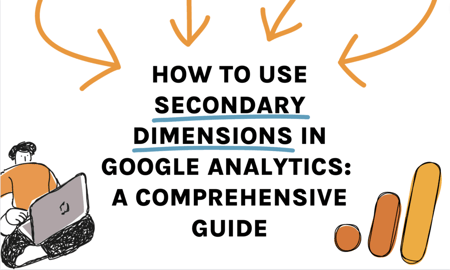Discover Deeper Insights With Secondary Dimensions
Second measurements function as a powerful tool in the world of information evaluation, using a nuanced point of view that exceeds surface-level observations. By including these dimensions right into your logical approach, you unlock to a realm of hidden understandings and beneficial relationships that can significantly affect your decision-making processes. The capability to divide data from numerous angles supplies a more thorough view of the underlying factors at play, clarifying details that may or else go unnoticed. Stay tuned to uncover exactly how secondary measurements can change the method you interpret and leverage your information for tactical advantages.
Benefits of Additional Dimensions

Among the vital advantages of second measurements is the capability to enhance the context of the key information. This included context makes it possible for analysts to draw even more precise verdicts and make notified decisions based upon a much more extensive sight of the information. Second dimensions assist in providing a more all natural view of the relationships between various variables, therefore aiding in the recognition of underlying aspects that may influence the primary dataset.
Fundamentally, secondary measurements play an important role in enriching data analysis procedures, supplying a much more nuanced viewpoint that can result in actionable referrals and useful understandings.
Execution Tips for Additional Dimensions
Carrying out second dimensions successfully needs a critical method that straightens with the certain goals of the data analysis procedure. To begin, it is crucial to clearly define the goals of the evaluation and identify the essential metrics that will supply the most valuable understandings - secondary dimensions. Select additional measurements that complement the primary dimensions and aid in uncovering deeper patterns or correlations within the data
When carrying out secondary dimensions, it is vital to think about the context in which the evaluation will certainly be conducted. Comprehending the target market and their information needs will certainly guide the selection of pertinent secondary dimensions that add purposeful context to the primary data points. In addition, make certain that the additional measurements chosen are compatible with the primary measurements and can be properly compared or integrated to remove important insights.
Additionally, it is recommended to test different combinations of additional and main measurements to discover various perspectives and uncover surprise partnerships within the information. Consistently refining the selection and reviewing of additional measurements based upon the progressing logical demands will certainly ensure the analysis remains informative and relevant.
Studying Data With Second Dimensions

When evaluating data with additional measurements, it is essential to consider how various variables interact with each other. By cross-referencing key data with additional measurements, analysts can discover connections and dependences that use a more all natural view of the data. This method not only boosts the precision of insights however also aids in making more educated choices based upon the searchings for.
Moreover, analyzing information with second dimensions makes it possible for the identification of outliers or abnormalities that might influence read the total analysis. By diving deeper this link into the information via additional dimensions, analysts can get a more profound understanding of the underlying elements driving the fads observed in the key dataset.
Making The Most Of Insights Through Additional Measurements
To draw out a higher degree of deepness and accuracy from information analysis, leveraging additional measurements is critical for taking full advantage of insights. By incorporating additional measurements right into your analysis, you can discover important relationships and patterns that may not be quickly apparent when considering information via a primary dimension alone. Second dimensions allow you to slice and dice your information better, providing an extra detailed understanding of the factors affecting your metrics.
When made use of effectively, second dimensions can enhance the context of your key information, supplying a much more nuanced point of view on your evaluation. By adding secondary dimensions such as geography, customer, or time demographics, you can gain a deeper understanding of just how various sectors engage with your web content or items.
In addition, additional dimensions can assist you determine outliers, trends, and correlations that might or else go unnoticed. By discovering your information from multiple angles, you can remove richer understandings and make more educated choices based on a detailed understanding of the underlying variables at play.
When Utilizing Second Dimensions,## Usual Blunders to Prevent. secondary dimensions.
When including additional measurements right into data analysis, it is necessary to be conscious of typical blunders that can prevent the removal of beneficial insights. One prevalent error is the misuse of additional measurements without a clear goal in mind. It is vital to specify specific goals and inquiries before picking additional dimensions to guarantee they line up with the analysis purpose.
An additional mistake to prevent is overcomplicating the analysis by consisting of a lot of secondary dimensions all at once. This can cause details overload and make it testing to attract significant conclusions from the data. It is a good idea to begin with a couple of appropriate additional dimensions and slowly include extra as required.
Moreover, ignoring data honesty problems can dramatically influence the accuracy of insights originated from second measurements. Insufficient or inaccurate data can misshape the analysis results and misinform decision-making processes. Routinely confirming and cleaning up the information is important to guarantee the reliability of the insights created.
Final Thought
In verdict, the tactical use this link of secondary measurements in data evaluation offers an effective tool for opening much deeper understandings and boosting decision-making processes. By integrating extra layers of information, experts can get a much more extensive understanding of their dataset, discover surprise patterns, and determine key variables influencing results. Through cautious factor to consider and execution of secondary dimensions, researchers can make best use of the value of their data and drive informed decision-making in different fields.
Select secondary dimensions that enhance the main measurements and help in uncovering much deeper patterns or relationships within the data.
In addition, make sure that the secondary dimensions picked are suitable with the key measurements and can be effectively contrasted or incorporated to extract important insights.
Using additional measurements in data analysis improves the depth and breadth of insights derived from the primary information points. By cross-referencing primary information with secondary dimensions, experts can discover correlations and reliances that offer a more all natural view of the information. By integrating second measurements into your evaluation, you can discover beneficial connections and patterns that may not be immediately evident when looking at information with a primary dimension alone.